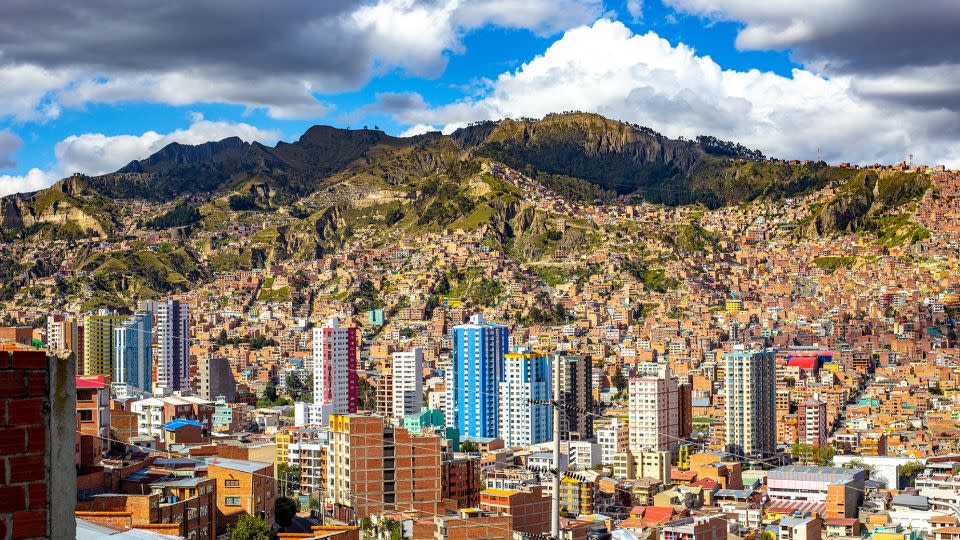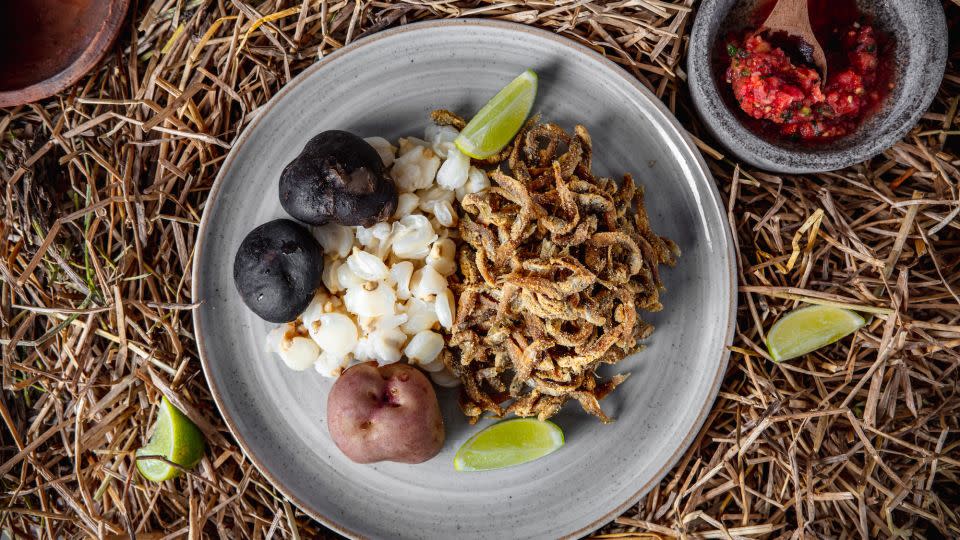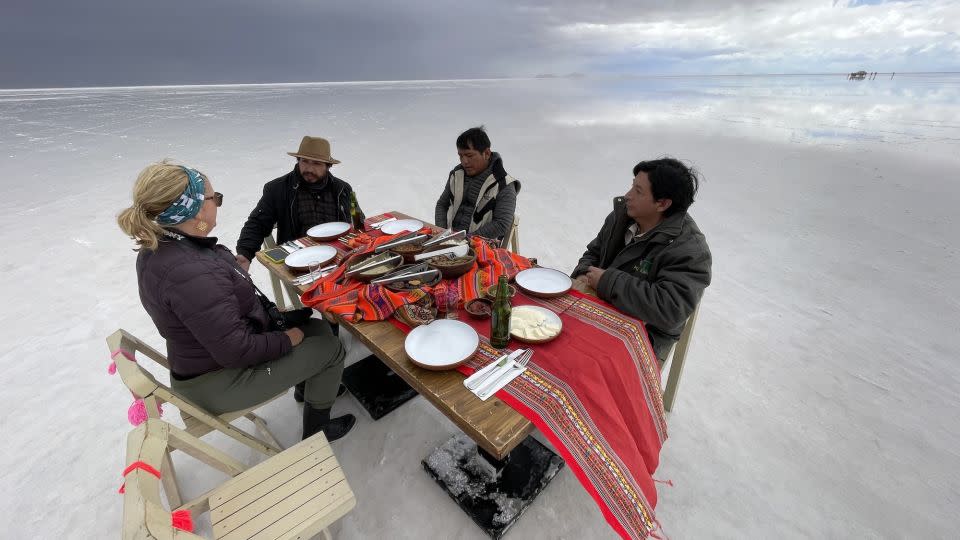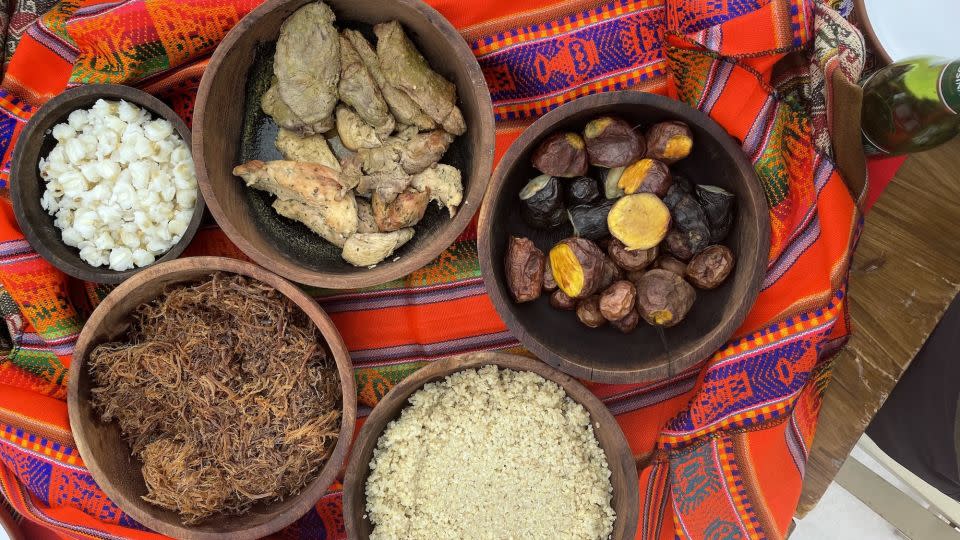Why this is Latin America’s next dining destination
Bolivia doesn’t seem like an obvious foodie destination. But the big, landlocked South American country is making waves in the culinary world via top-notch restaurants and transforming foodways pioneered by the ancient Inca and Aymara peoples into modern fusion dishes.
Capital city La Paz boasts three eateries — Gustu, Ancestral and Phayawi — currently ranked among the top 100 restaurants in Latin America. And more are waiting in the wings. And it’s not just La Paz. Bolivia’s food revolution has also spread to major cities such as Sucre as well as the Uyuni Salt Flats.
The new Bolivian cuisine kicked off about a decade ago, according to Marsia Taha, head chef at Gustu. “There was a generation of new chefs that had a mindset that we should be proud about our identity and our culture and our food,” Taha said.
Taha and other likeminded chefs in La Paz coalesced around the concept of “zero-kilometer cuisine” — using as many ingredients as possible that are raised or grown locally and having direct contact with the ranchers or farmers that provide those things.
“By showing that we believe in local products, we were able to show people that Bolivian cuisine could be as great as things coming from outside the country,” adds Sebastián Giménez, chef and co-owner of Ancestral.

Revolutionizing Bolivian cuisine
It’s not surprising that Gustu has been counted among the continent’s elite dining destinations since first opening its doors in 2013.
Co-founder Claus Meyer is a Danish culinary legend who helped pioneer the New Nordic food movement at the Michelin three-star Noma restaurant in Copenhagen, and Gustu is always mentioned among the continent’s top restaurants.
Merging Bolivia’s traditional ingredients and food culture with the contemporary Nordic model, Taha and Meyer fashioned a gastronomic melting pot that truly lives up to its name (gustu means “delicious” in the Quechua language of the Andes).
Among the signature dishes are raw Lake Titicaca trout with mango; llama with Amazonian vanilla and ajipa root; Amazon fish with goldenberries and a fermented yuca (cassava); and an out-of-this-world lamb tamale.
Taha says that even after a decade in business, she and Gustu’s other chefs are able to keep the concept fresh by traveling around Bolivia to learn about new ingredients and foodways. “Learning how people cook, how they grow their food, and so on. We also give a lot of liberty to our chefs to bring in new ideas.”

Variations on the theme
Located in the trendy Achumani neighborhood on the south side of La Paz, Ancestral occupies a cozy basement location with floor-to-ceiling windows looking out on a sunken garden. The food is new Bolivian with Basque and Nordic undertones, but the concept is open fire or parrilla-style cooking that revolves around the wood-stoked grill and oven.
“We’re inspired by the biodiversity of Bolivia,” says chef Sebastián Giménez. “We have jungle, valleys, altiplano, and very high places. We are also inspired by local products and local techniques. We only use Bolivian products, and we only serve Bolivian wines.”
But don’t expect traditional Andean or Amazon dishes. Ancestral offers a delicious fusion of old and new in offerings such as the chuletón ribeye steak, trout ceviche with grilled corn and sweet potato, and porchetta pork roast with Bolivian tubers and red aji sauce.
Manq’a takes another tack. Rather than fine dining, the ambience is decidedly casual, the tables spread across three floors of an old wooden townhouse in the boho Sopocachi neighborhood of central La Paz.
It’s especially busy at lunch, a mixed bag of local shoppers, politicians, students and the occasional tourist savoring dishes such as sopa de maní (peanut soup), gratinated cheese and native potatoes with humacha sauce, soft baked keperí beef from eastern Bolivia, and surubi catfish from the Amazon served with quinoa, tucupi cassava and edible flowers.

Food of the devil
The chefs at these top-shelf restaurants don’t have to look far for basic ingredients. Many of the building blocks of their fusion foods are native to the Andes valleys and foothills that extend all the way along Bolivia’s western side from Lake Titicaca to Argentina.
More than 4,000 potato types are cultivated in Bolivia and its Andean neighbors, many of them found in just a single, small valley. They come in various shapes, sizes, colors and slightly different flavors.
Even more than spuds, Bolivians cherish their quinoa. The country boasts more than 3,100 varieties of quinoa, which contrary to popular opinion is actually the seed of a flowering pseudocereal plant rather than a true grain.
An exhibit at the new visitor center in the silver mining town of San Cristóbal points out that Spanish conquistadors and padres considered quinoa the “food of the devil” and banned its consumption as a way to control the local indigenous people.
Five centuries later, NASA declared quinoa “the perfect food to grow in indoor greenhouses” during long voyages in outer space because of its resistance to adverse conditions (such as growing in the Andes), versatility and high protein content.
No longer vilified as Satan’s feast, it’s also an ideal ingredient for Bolivia’s new-wave cuisine.

Zero-kilometer goes wider
Sucre, the nation’s judicial capital in south-central Bolivia, isn’t as cosmopolitan as La Paz when it comes to food. But it’s gradually catching up.
Located across the street from the city’s Cathedral Basilica of Our Lady of Guadalupe, Joy Ride Cafe was founded as a tourist restaurant but evolved into a local hangout for date nights, after-work parties and Sucrense craving burgers, pasta and other global eats.
But right down the block is the fusion fare of El Solar. The seven-course degustation menu features dishes such as seafood rice flavored with Amazonian citrus juice, pork belly with pepper sauce and a creamy puree made from plantain and yuca; and beef loin with charque (llama jerky). All of this for 80 bolivianos (roughly $12).
Located in southwest Bolivia about 300 miles (500 kilometers) south of La Paz, the otherworldly Salar de Uyuni is the world’s largest and most spectacular salt flat as well as Bolivia’s top tourist attraction. Once upon a time, it was primarily a backpacker destination, but in recent years, more well-heeled travelers (and social media influencers) have sparked a transformation of the local dining scene.
Tika restaurant at the Jardines de Uyuni Hotel looks ordinary from the outside, but the kitchen creates Andean-inspired dishes that easily match anything found in Bolivia’s big cities.

Chef Tania López also uses the term “zero-kilometer cuisine” to describe the menu at Tika. Among her signature dishes are a sun-dried, shredded llama jerky with local white cheese and a piquant yellow chili pepper sauce, bubbling k’alaphurka corn soup, and lake trout filets in a basil pesto “lagoon” with quinoa risotto.
López says one of the closest dishes at Tika to what the ancient Inca may have eaten is the llama potojchi. “Preparation takes more time than beef,” she explains of a succulent dish that resembles goulash. “We still do this in the traditional way from many centuries ago — heated on lava rocks.”
Dishes that the Incas never tasted — but would probably die for — are Tika’s house-made desserts, in particular the quinoa and purple corn ice creams.
Tika also does upscale takeaway, meals for a remote picnic that diners can enable on their own or via a 4x4 adventure with Hidalgo Tours, which sets up a table, chairs and bar at a remote location in the middle of the salt flat.

But that’s not to say that Bolivia’s food revolution has reached every nook and cranny.
An hour boat ride from the mainland in the middle of Lake Titicaca, the Isla del Sol (Island of the Sun) is the legendary birthplace of Inca civilization and a place still deeply rooted in the Andean past.
On its open-air terrace overlooking the water, the island’s Tacana restaurant serves a traditional pachamanca lunch that includes llama, lake fish, potatoes, corn and other locally sourced dishes — not all that different than what the Inca rulers would have eaten during their pilgrimages to the island more than 500 years ago.
For more CNN news and newsletters create an account at CNN.com


